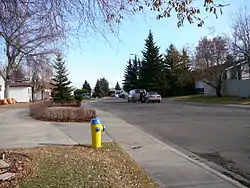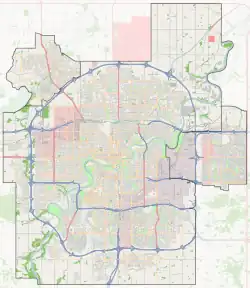Ekota | |
|---|---|
Neighbourhood | |
 Residential street in Ekota - Fall 2008 | |
 Ekota Location of Ekota in Edmonton | |
| Coordinates: 53°26′56″N 113°26′38″W / 53.449°N 113.444°W | |
| Country | |
| Province | |
| City | Edmonton |
| Quadrant[1] | NW |
| Ward[1] | Karhiio |
| Sector[2] | Southeast |
| Area[3][4] Community | Mill Woods Knottwood |
| Government | |
| • Mayor | Amarjeet Sohi |
| • Administrative body | Edmonton City Council |
| • Councillor | Keren Tang |
| Area | |
| • Total | 0.82 km2 (0.32 sq mi) |
| Elevation | 690 m (2,260 ft) |
| Population (2012)[7] | |
| • Total | 2,560 |
| • Density | 3,122/km2 (8,090/sq mi) |
| • Change (2009–12) | |
| • Dwellings | 947 |
Ekota is a neighbourhood in Edmonton, Alberta, Canada. It is located in Knottwood, in Mill Woods. In the Cree language, Ekota means 'special place.'
The neighbourhood is bordered on the north by 23 Avenue, on the east by 66 Street, and on the south and west by Mill Woods Road South.
Demographics
In the City of Edmonton's 2012 municipal census, Ekota had a population of 2,560 living in 947 dwellings,[7] a -3.6% change from its 2009 population of 2,655.[8] With a land area of 0.82 km2 (0.32 sq mi), it had a population density of 3,122 people/km2 in 2012.[6][7]
At the 2001 census there were 2,830[9] people residing in the neighbourhood. The population is ethnically diverse with almost three out of every four residents providing multiple ethnic groups in the census. Only one in four identified with a single ethnic group. The number identifying themselves as aboriginals was significantly less than 1%. Where residents indicated a single ethnic group, the following were the most common groups indicated (percentages as proportion of total population).
| Ethnic Group | Number | Percent |
|---|---|---|
| Canadian | 290 | 6.0% |
| German | 185 | 3.8% |
| East Indian | 185 | 3.8% |
| Chinese | 115 | 2.4% |
| Filipino | 105 | 2.2% |
| Polish | 90 | 1.9% |
| English | 80 | 1.7% |
| Ukrainian | 50 | 1.0% |
Schools
There are two schools in the neighbourhood. Pupils in the Edmonton Public School System attend Ekota Elementary School, while pupils in the Edmonton Catholic School System attend St. Clement Catholic School.
Shopping and services
Residents have good access to shopping with the Mill Woods Town Centre shopping centre located to the north east in the neighbourhood of Mill Woods Town Centre.
Just to the north of Mill Woods Town Centre, in the neighbourhood of Tawa, is the Grey Nuns Community Hospital and the Edmonton Police Service's South Division Headquarters.
Together, Mill Woods Town Centre and Tawa form the commercial and service core of the entire Mill Woods area.
Immediately to the north of the neighbourhood is Mill Woods Park located within is the Mill Woods Recreation Centre.
Surrounding neighbourhoods
References
- 1 2 "City of Edmonton Wards & Standard Neighbourhoods" (PDF). City of Edmonton. Archived from the original (PDF) on May 3, 2014. Retrieved February 13, 2013.
- ↑ "Edmonton Developing and Planned Neighbourhoods, 2011" (PDF). City of Edmonton. Archived from the original (PDF) on September 4, 2013. Retrieved February 13, 2013.
- ↑ "The Way We Grow: Municipal Development Plan Bylaw 15100" (PDF). City of Edmonton. 2010-05-26. Archived from the original (PDF) on May 2, 2015. Retrieved February 13, 2013.
- ↑ "City of Edmonton Plans in Effect" (PDF). City of Edmonton. November 2011. Archived from the original (PDF) on October 17, 2013. Retrieved February 13, 2013.
- ↑ "City Councillors". City of Edmonton. Retrieved February 16, 2014.
- 1 2 "Neighbourhoods (data plus kml file)". City of Edmonton. Retrieved February 13, 2013.
- 1 2 3 "Municipal Census Results – Edmonton 2012 Census". City of Edmonton. Retrieved February 22, 2013.
- ↑ "2009 Municipal Census Results". City of Edmonton. Retrieved February 22, 2013.
- ↑ Population data is available from both the Ekota Neighbourhood Profile and the Community Services Neighbourhood Profile, with both prepared by the City of Edmonton. The total population in the ethnic origin table in the Ekota Neighbourhood Profile is significantly higher than the number of people given in other parts of the same document. The population distribution nunmbers (including percentages) used here are taken from the ethnic origin table, while the total population is the lower number from the Community Services Neighbourhood Profile